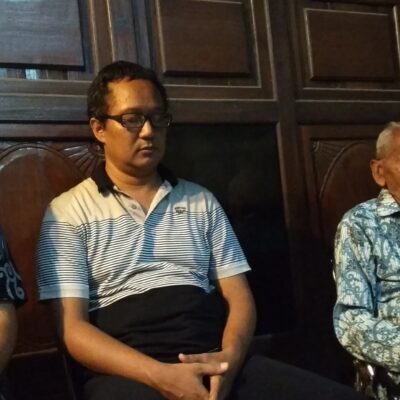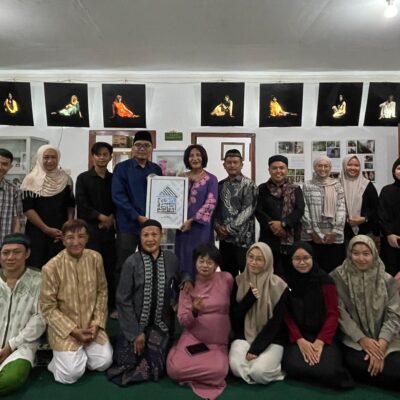Scholars of Indonesia and the Indonesian language have regularly voiced their concerns about Australia seemingly turning away from Indonesia. This disinterest is evidenced in well-documented declines in enrolments in Indonesian language programs in Australian schools and universities.
While these accounts and earlier ones point to a need for more investment on multiple fronts, Howard Manns and colleagues advocate for the formation of Indonesian teaching communities of practice who collaborate on the coordinated creation of open access materials that are relevant to the lives of those who will use them.
This paper reports on our first step in taking up this invitation with the support of grants from the Australia Indonesia Institute and the Campbell bequest held with the School of Languages and Cultures at the University of Queensland. In doing so, we lay out the scholarly foundations underpinning our design choices for this open access material. The material seeks to engage advanced learners of Indonesian-as-a-foreign language in the context of post-method language teaching, which eschews any one approach (e.g., the communicative approach) in favour of using a range of pedagogies to accommodate different learning styles.
Why have we chosen this topic and these ways of facilitating learning Indonesian?
Research into how languages are learned repeats a familiar story about learning more generally: we do our best job at learning when we are curious about a topic. This research and our own classroom experiences show that there will be many topics of interest within one student cohort. This is one of the reasons that Indonesian language curriculums of the past, such as Suara Siswa and the Teaching Indonesian as Foreign Language (TIFL) crafted learning modules that covered a number of topics. With much less funding than either of these Australia government initiatives from the early 1990s, our current project was limited to creating one module for third year Indonesian-as-a-foreign language students.
Post-method approaches to language teaching also recognize that in one classroom, in this case third year students, students will have varying abilities. For example, some students will only have four semesters of university Indonesian behind them; others may have studied Indonesian in primary school; while others may have lived in Indonesia for a time, and so on. One way that this variability can be accommodated is via Penny Ur’s practical suggestion found in her book “A course in language teaching: practice and theory”. Essentially, she notes that variability in student abilities is inevitable and can be accommodated by inviting students to complete at least one of a number of problems within any one task set in class. The more advanced learners will do more while the less advanced will be able to get a couple of problems completed. Just as importantly, using this strategy gives both sets of learners the opportunity to achieve.
We focused on the subject of environmental degradation which seemed to attract interest from young people globally. While we could have focused upon environmental degradation in many areas, for our first topic we chose to look at youths’ experience of flooding events in Australia and Indonesia. There were two reasons for this focus:
- First, as consumers of mainstream media we were very familiar with the regular reporting of the intense flooding across Australia in the very recent past. While poor urban planning, land use, and unscrupulous developers building in flood prone areas are often the reason why communities are impacted by flooding, climate change has exacerbated the flooding effects that come with La Niña cycles. The end result, as many readers will know or even have experienced first-hand, is multiple floods over a short period of time or flooding in places that weren’t previously impacted.
- Second, mainstream media often highlights the experience of those impacted by these flooding events. Our own consumption of ABC news attests that these interviews tend to focus on interviewees in their late twenties onwards. Rarely, do we hear the voices or experiences of impacted youth, such as those studying at university. This lack of voice is also common in Indonesia, especially around the issue of tidal flooding.
Researcher Henny Warsilah points out that 60 percent of Indonesia’s 270 million plus inhabitants live in coastal areas. In these areas, tidal flooding is a well-researched problem, especially on the north coast of Java. Estimates of impacted populations across the archipelago range from four to 23 million. The reasons for this large variation are complex and relate to different inter-related projections about land subsidence, mangrove habitat destruction, sea-level rise, and climate change induced extreme weather events. With the exception of Lucas Ley’s anthropological study, participants in studies of tidal flooding have usually been NGO workers, community leaders or experts. Typically, little attention is paid to the experiences of youth (as with the case in Australia). Our recent analysis of mass-mediated stories about tidal flooding in Indonesia also suggests that youth voices continue to be undervalued.
Our design of this material sought to address this lack of voice by inviting youth from Australia and Indonesia to tell others about their experiences of flooding. After training Australian and Indonesian undergraduates in interviewing techniques, none of whom had been impacted by flooding, we made connections with youth groups in Australia and Indonesia. Subsequently, our undergraduates recorded audio-visual interviews with flood-impacted peers from Australia and Indonesia. With these undergraduates and participants, both of whom are co-researchers, we then collaboratively transcribed and edited the interviews, created subtitles in English and Indonesian, uploaded them to our project YouTube site “Flooding Youth Futures” and collectively wrote and edited this article about how to use these materials.
The video interviews hosted on YouTube were complemented with five other sets of activities that can assist in the creation of a pedagogic spiral (e.g., the re-use of vocabulary, topics, grammar, pragmatic aspects of language use, and so on in increasingly demanding tasks) along with suggestions for their use and assessment. Thus far, our learning materials are related to Indonesians’ experience of tidal flooding in Indonesia. All of this material is available in the “engagement and advocacy” tab of the Communicating Flooding website of the School of Languages and Cultures at the University of Queensland. The material accompanying the YouTube interviews includes workbooks which enable learners to test their comprehension of the interviews while also raising their awareness about the important issue of saying “you” and “I” in Indonesian. This is part of a wider and long-term push toward the use of authentic materials in language classrooms in general and Indonesian-as-a-foreign language classrooms in particular.
The Indonesian settings in which we hope our learners will eventually find themselves, whether as an in-country student, researcher, public servant, businessperson, etc. are also complex and unknown. They will typically involve interactions in one or more of the many varieties of Indonesian language found throughout the archipelago, each underpinned by interactants’ emerging or desired social relationship with Indonesians, among other things. Our use of actual broadcast news stories about tidal flooding from various news outlets reflects our concern with the variability of Indonesian and the need to raise learner awareness about the complexities of language use in Indonesia, something that has been advocated for some time. Using a version of Indonesian that approximates Indonesia’s ideological standard has limitations, especially if one wants to form closer social relationships with Indonesians. As Joe Errington and other researchers of language use in Indonesia have shown, contexts that are ideologically associated with standard Indonesian, such as inter-ethnic encounters, mass-mediated encounters, and encounters in government offices, in reality actually involve a lot of local regional and colloquial language mixed with standard Indonesian.
Like our YouTube interview series, the questions accompanying these broadcasts cover both comprehension and questions that sensitise learners to different ways of saying “I” and “you”. We provide a downloadable excel spreadsheet with the YouTube link to these broadcasts, the comprehension question and transcripts of the dialogue. These transcripts can also be used to create vocabulary and grammar activities, focused listening activities (e.g., transcription), word searches, and so on. Our analysis of these news reports also highlighted five reoccurring themes. This formed the sub-topics for the activities we describe below. These themes included: evacuation to the homes of friends and family; raising impacted homes and their foundations; community mitigation projects; government aid; and sleeping on their fishing boats.
Multiple screenshots of the television broadcast interviews about tidal flooding also serve as the basis for two task-based activities. The first is an information gap activity where learners are provided with photos that are not identical. Learners are then invited to use all the Indonesian that they can muster to work out the differences in their respective images (without showing their partner their photo). The second set of material is made up of a collage of eight images from these news broadcasts. Learners are invited to choose at least four and tell their partner a story that links these images together. In addition to listening to this story, partners are invited to guess which images are being talked about—a type of gamification of learning (introducing game elements to increase engagement).
So far, we have described the materials that, with the exception of transcription activities, focus on speaking and listening skills. We have also provided a series of downloadable activities that incorporate all four macro skills (listening, speaking, reading writing). This material is based on web-based stories from the Central Java-based newspaper, Suara Merdeka “Voice of Freedom”. This activity is a competition between pairs of students, who are invited to take on the role of either reader or transcriber. The reader, who is located at the opposite end of the classroom to the transcriber, is then invited to read and memorize as much of the passage as they can and then walk to the transcriber and repeat what they remember of the passage. Our materials also include links to websites that deal with disaster mitigation in Indonesia and a list of references to scholarly literature on tidal flooding.
Conclusion
In moving towards an open access set of materials for tertiary educators tasked with facilitating the learning of Indonesian as a foreign language, we note that there is much left to do. We have yet to incorporate suggestions for use in contexts where there are many students from Indonesia on campus. For example, collaborative projects between Indonesian language learners and Indonesians studying at our campuses can not only facilitate deep learning about a topic but also further our students’ ethnographic skills, especially those that can focus on learning socially appropriate uses of Indonesian, as well as close social relationships between Australian and Indonesian youth.
We are also aware that creating learner-centred material is ideal, so the creation of this material for an unknown cohort of learners means that its use will necessarily rely on our colleagues to determine whether this topic is something that interests any of their cohort of the next generation of Indonesianists. Once we have heard from colleagues who have trialled the material, we will have better idea of their utility. We can then move forward forming a community of practice with like-minded educators, perhaps developing further materials on other third year topics, together with material for first and second year Indonesian.
Authors: A/Prof Zane Goebel, Dr Udiana Dewi, Jawad Yuwono, Melinda Wanto, Raihan Yates, Sakura Savelieva, Delfina Chrisyandra, Oktolita Elsanadia, Andreas Wijaya, Kusnadi, Atsila Husna, Muhammad Darmawan, Lukman Hakim & Djoko Basuki.
Main image: Student researchers working together with peers impacted by flooding, BINUS university, Semarang Campus, February 2025. Credit: Author.




